NB: Phiture is hiring for a key role to lead our evergrowing ASO team. You’ll be responsible for leading and overseeing the success of our App Store Optimization service team and help Phiture to lead the way in mobile growth. Read more about the role here
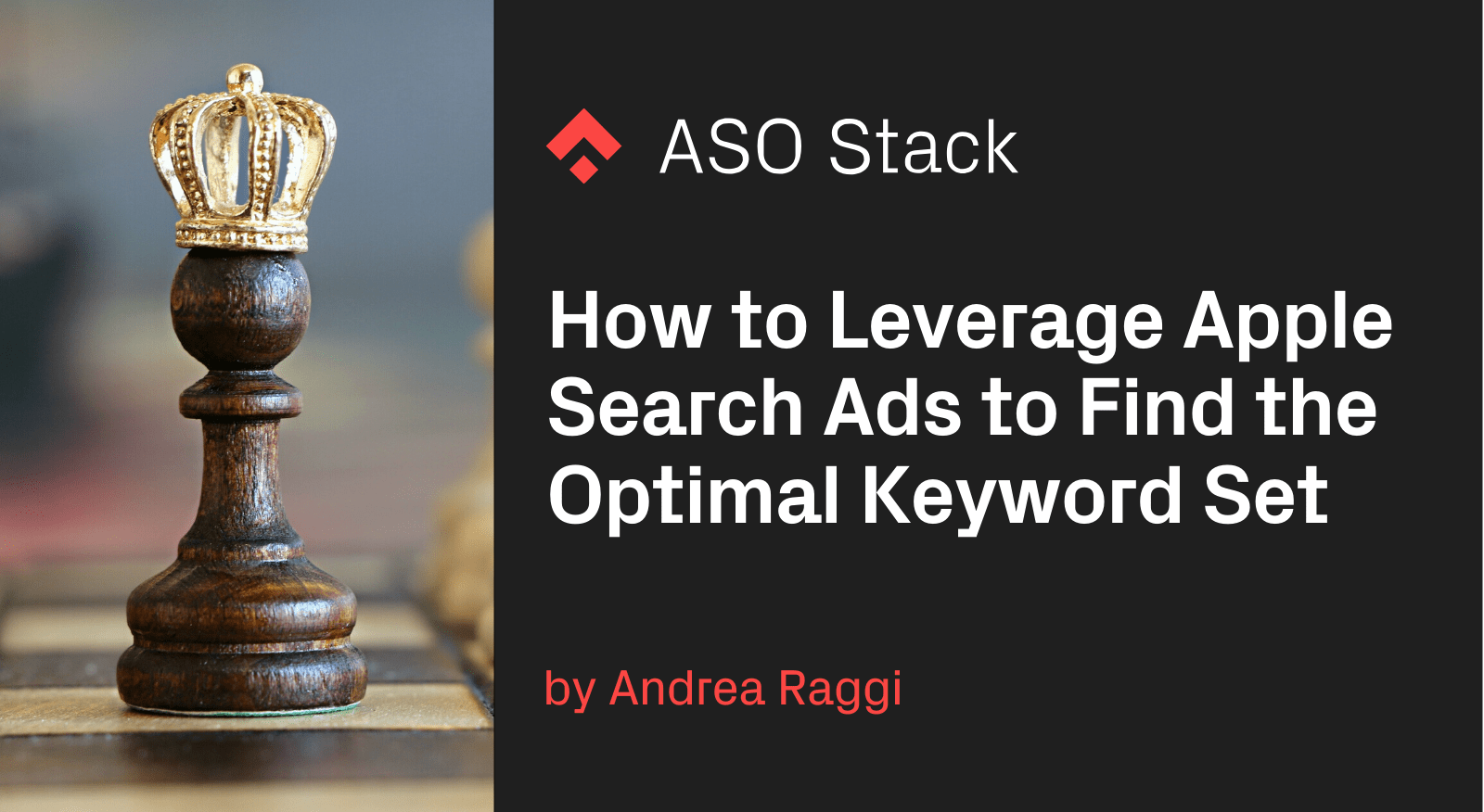
App Store Optimization (ASO) practitioners will know well what I mean by this statement: ASO is becoming increasingly complex. We all know that there are literally thousands of keywords that your app could be targeting, as well as lots of competitors, ASO tricks, and much more. As if all these things were not enough already, we have the App Store and Google Play changing the rules of the game by altering algorithms and/or adding new features on a regular basis.
This complex and ever-changing environment can indeed create confusion. As a matter of fact, the presence of different changing elements may cause you to focus on points that may not be that relevant. Specifically when dealing with crafting App Store metadata, choosing the right keywords is pivotal to succeed in a hyper-competitive environment. Therefore, how do I make sure I’ll find the most appropriate keywords for my app? How do I find high volume keywords that enable me not only to attract users, but most importantly generate revenue?
In this article we’re going to cover how you can find a methodical solution that will help you to maximize revenue instead of downloads, when dealing with the 100 character keyword field of the Apple’s App Store. Our research question will be “how can we exploit all available resources to have a data-driven approach that helps us to choose the optimal keyword set for the App Store?”
Keyword Research & Volume
Let’s start with an example. Let’s pretend we’re part of the ASO team of “The Economist”. As you may already be aware, The Economist offers insights and opinion on international news, politics, business, finance, science, technology, etc.. It is a subscription-based magazine released weekly.
As The Economist covers many topics, there could be quite literally thousands of keywords we could target to craft our App Store metadata. So, where do we start? We could start our keyword research by having a brainstorming session. Below you can see a few keywords that I came up with.
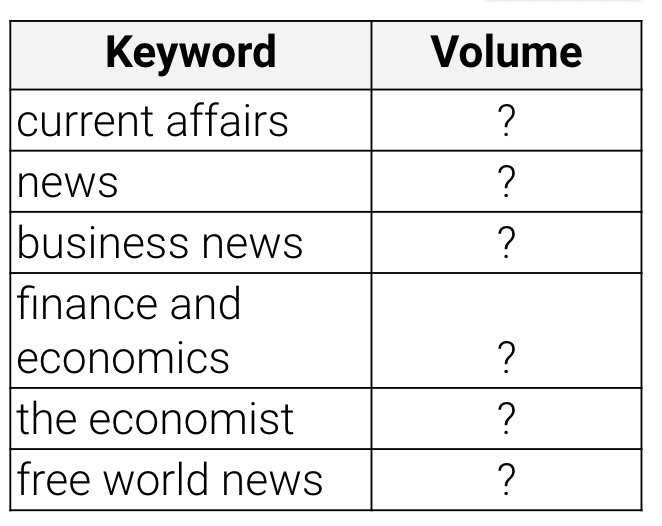
Of course, when doing keyword research you should also use other tools and not rely entirely on brainstorming. In this case, tools like Apptweak can help with conducting a thorough keyword research. The keywords I listed may all be relevant for The Economist, but how do I find out which keywords receive a high number of search queries? We’ll now refer to the number of search queries as “Volume”. We need to know which keywords are likely to deliver more traffic (or a higher Volume) because the most searched keywords help your app reach the top of users’ search results. These keywords then allow us to better capture users’ needs and desires.
Therefore, Volume is extremely relevant for your business, but… The problem with Volume is that it has always been a black box. So, what can we look at when we’re trying to understand Volume?
Google Keyword Planner
The Google Keyword Planner (GKP) has been utilized since the conception of ASO. It is a tool embedded in Google Ads which helps you discover new keywords. By selecting a specific query, you would get recommendations for similar keywords with the respective estimated average monthly queries. It is a very interesting tool for ASO and Search Engine Marketing (SEM) because it yields keyword ideas that can help you reach people interested in your product or service.
Notwithstanding its powerful suggestions, the main drawback of Google’s Keyword Planner is that it retrieves data for web-related keywords. This implies that App marketers using the GKP are brutally applying web data to App Store search data. We definitely need to take this into consideration when we’re doing keyword research for App Store searches.
Therefore, the Google Keyword planner for app marketers should be used merely as a discovery tool for keywords, and only as a proxy tool for Volumes because web search and App Store search are not one and the same.
In fact, if we generalize, app store queries are usually:
- Less long tail (implying the use of just a few words)
- More typos
- No questions, nor research type queries
As a practical example, you wouldn’t look on the app store “how to get rid of an hangover”, would you? As another example, if you were to Google for “highway to hell” , the famous ACDC song, you’d be certain you could find it. However, you would not be able to get the desired results in the App Store (see below).
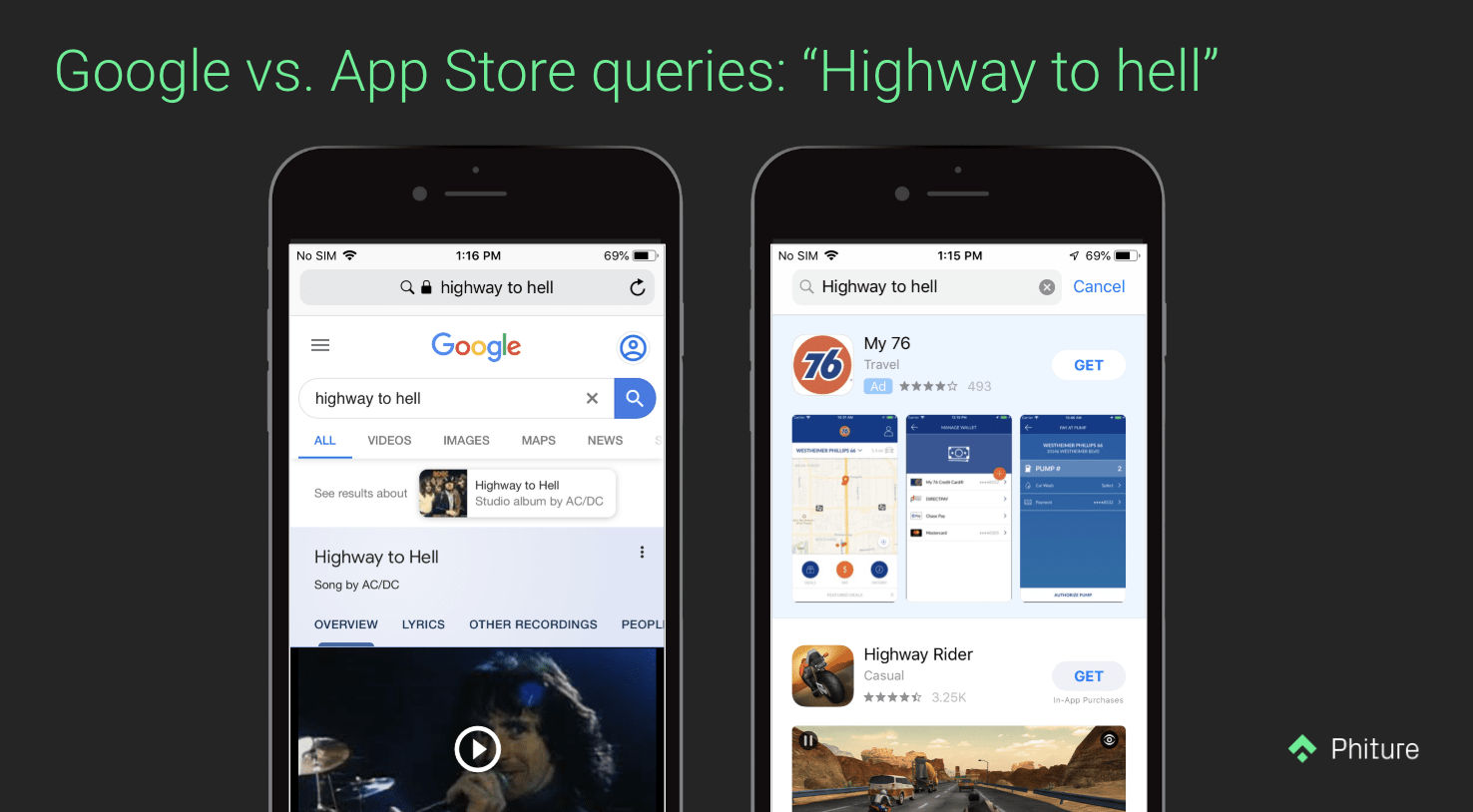
To further demonstrate the example that the Google Keyword Planner should be used cautiously for app store search data, take a look at the average number of queries you would get. GKW suggests between 10K and 100K as average monthly queries for the US.
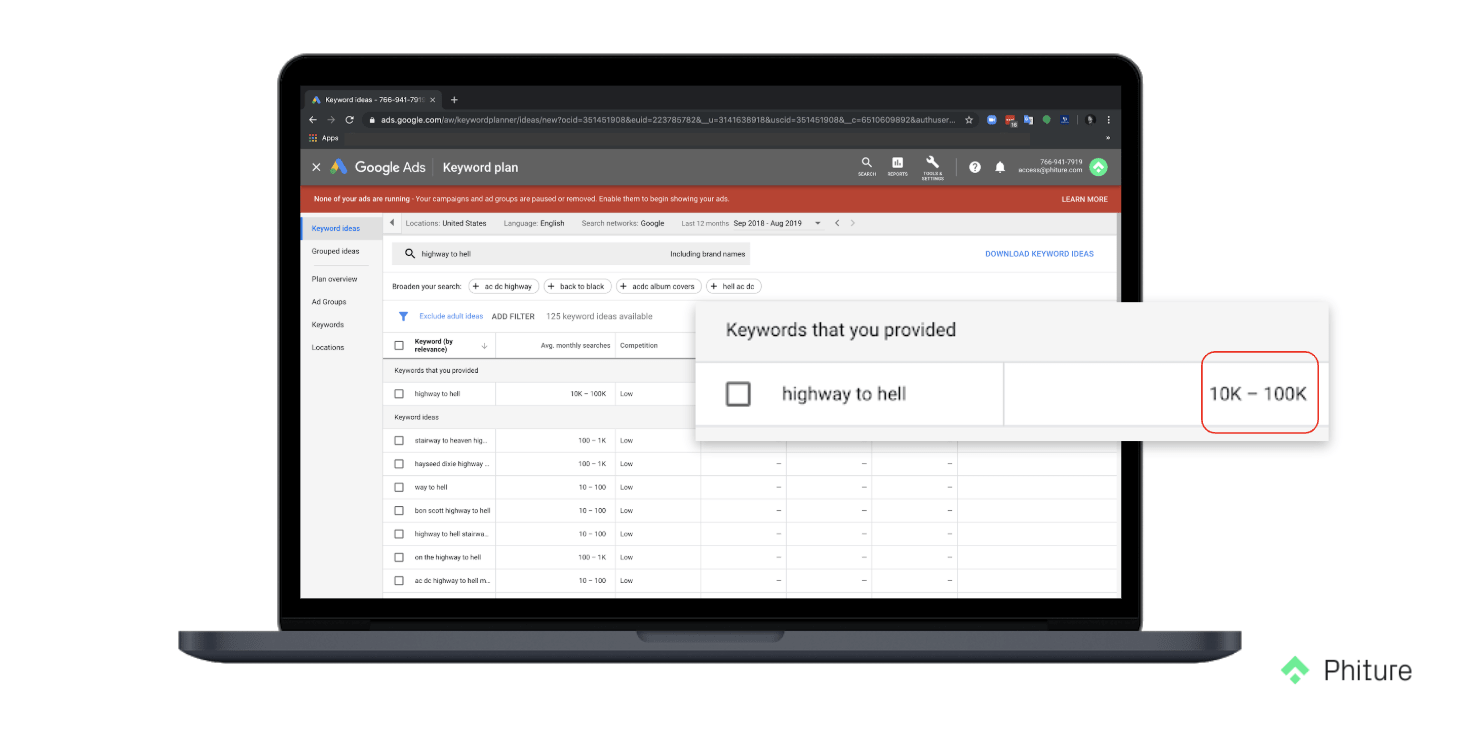
However, by doing a quick research in Apptweak, we can see that the Search Popularity (SP) on App Store is only 11, which is a relatively low number considering that the SP goes from 5 to 100 (more on SP later in the article).
Autosuggestions and Priority Scores
Another way app marketers can understand where the Volume is lying behind keywords are autosuggestions. Google Play and the App Store show auto-suggestions in the search boxes, where we can (for now) assume that the first results appearing are the most popular ones.
Smart cookies in ASO may know that, with Apple’s Autosuggestions, a “Priority Score” is embedded in each specific keyword. To receive the priority score, you can send a request to Apple’s internal API. In return, you would receive the information for that request. Here is how the request would look like for the query “learn” in the US:
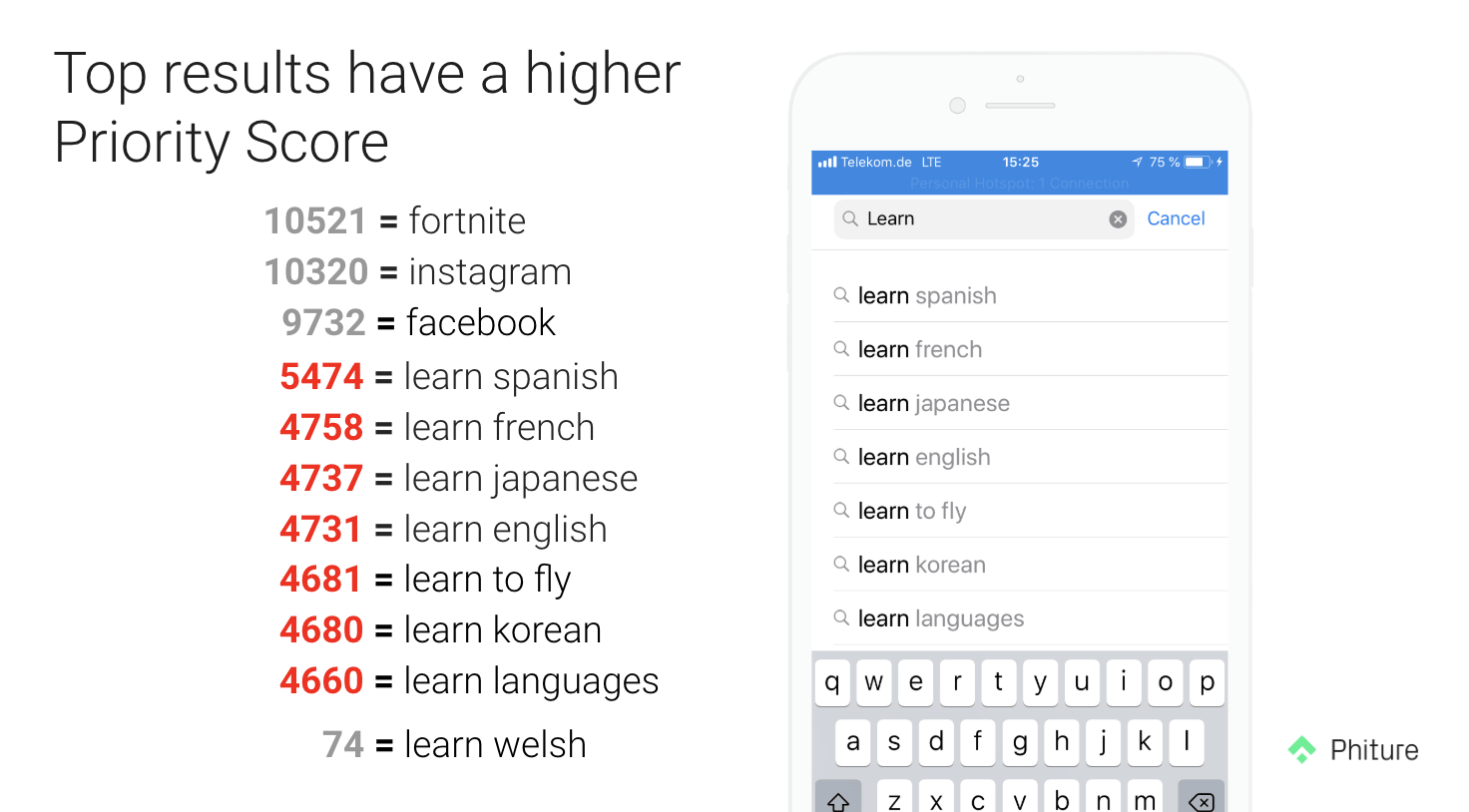
For my specific query, “learn”, I received a list of priority scores (see picture above). As we assumed earlier, Apple’s API response shows that keywords appearing in higher positions in the autosuggestions will be searched a lot more than keywords that don’t. As a matter of fact, the higher the position in the autosuggestion, the higher the priority score. Of course, there are some search terms such as Fortnite, Instagram and Facebook that have a much higher priority score that reflects the high popularity of these keywords. In contrast, “learn Welsh” has a very low priority score.
Priority scores are still very useful and can be exploited in your ASO strategy for those markets where Popularity Scores are yet not available. For instance, Priority Scores can be used in markets like Brazil where Apple Search Ads have not yet been released.
Popularity Score
Popularity Scores were released in 2016 with the launch of Apple Search Ads. This indicator was long awaited by the mobile app industry because it provides an indication of the level of popularity (which implies the volume of queries typed by users) of any given keyword. Basically, the Search Popularity indicates whether a keyword is popular or not in App Store searches.
In the Apple Search Ads console, you have the possibility to see what the keywords’ popularity is. Unfortunately, that’s only indicated as a blue dot, where the higher number of blue dots shows a higher Popularity Score. However, by inspecting the HTML element, you’d be able to know what exactly the popularity score would be (see below).
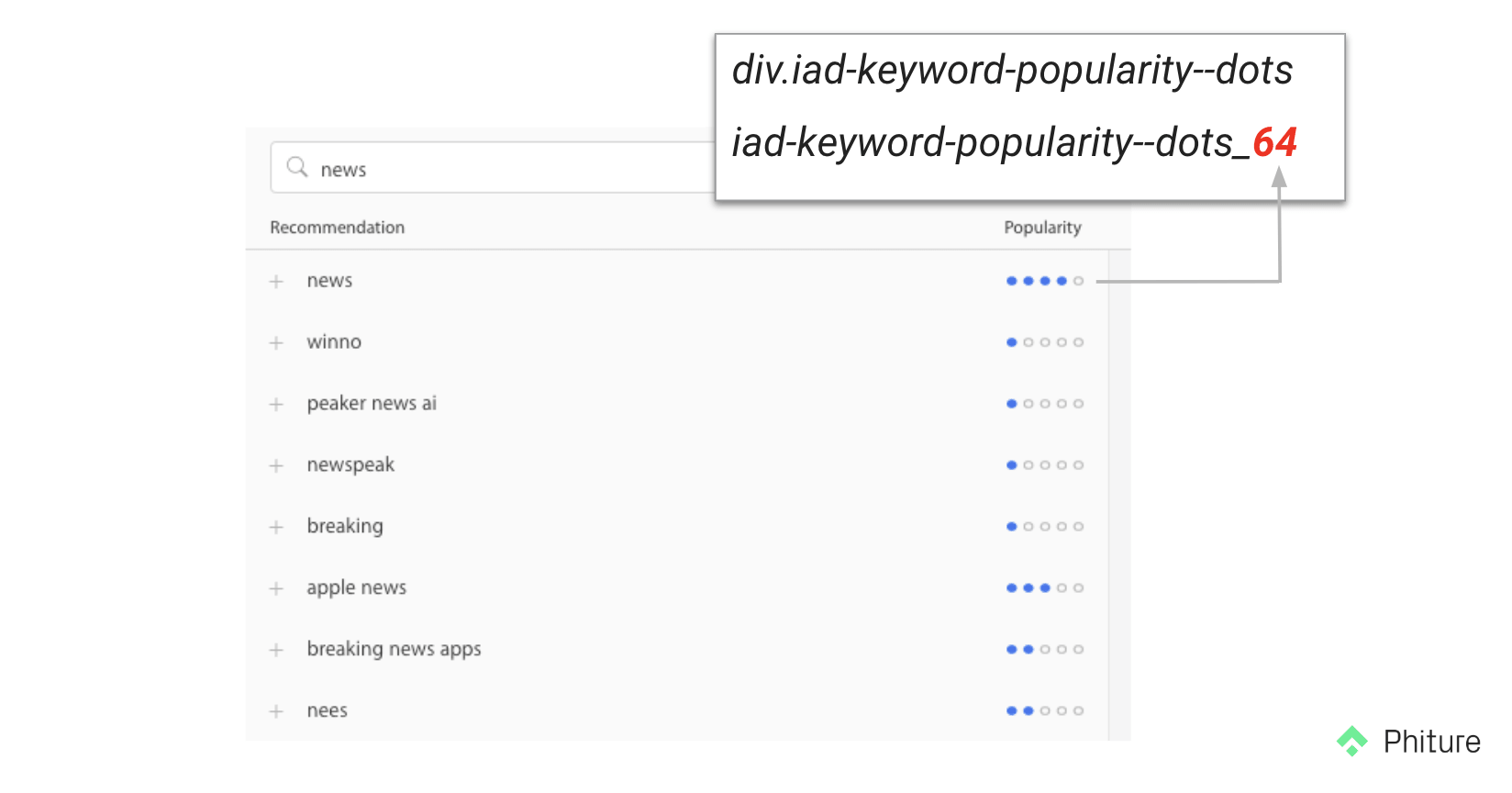
*SP scores can be retrieved through Apple Search Ads’ interface, but also through other ASO tools like Apptweak.
But what’s 64? The Search Popularity (SP) score ranges from 5 to 100 and it shows an indication of users who have entered a search query in a particular storefront. The value isn’t absolute and depends on the population of a particular storefront: 50 in the American storefront will differ from one in the UK in absolute terms (SearchAdsHQ, 2019). Furthermore, the value is an exponential rather than a linear function, meaning that a SP of 90 is not 3x 30, but actually much more than that (a visual example is provided in the picture below).
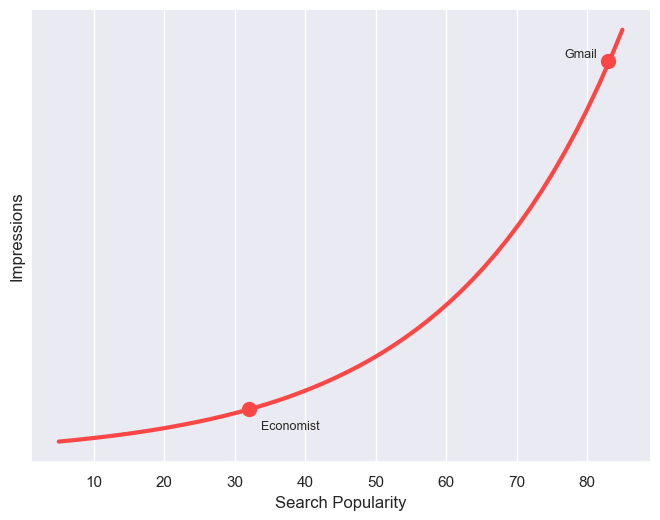
Search Popularity is the first piece of our puzzle helping to craft the optimal keyword set. It shows an indication on the search volume for your keywords. Hence, Volume is fundamental because it helps to target keywords that attract users. This metric is the very first indication you should retrieve to create the optimal keyword set for your App.
Conversion
Once we have gathered our Search Popularity Scores, we can start focusing on the second highly important element: Conversion. Yes, our keywords may be searched from users, but will they generate conversions? When talking about conversions, in this case, we want to consider revenue-generating events (subscriptions, purchase, etc.). Conversions are crucial for your business as they bring in revenue. Therefore, we want them to be included in our optimal keyword set.
But how could I possibly assess the conversion for every keyword? You need two things which are increasingly important if you are working within the mobile ecosystem: Apple Search Ads and a Mobile Measurement Partner (such as Adjust or Appsflyer).
On the one hand Apple Search Ads (ASA) allow you to target high intent users who specifically come to the App Store with the intent to download an app. Apple Search Ads enable you to test a variety of keywords that are relevant for your app and see which ones are performing better. This is the reason why I consider ASA a treasure of data that cannot be overlooked: it can objectively identify powerful and persuasive keywords that deliver revenue-driven actions (with the support of a Mobile Measurement Partner — MMP).
But how to make sure you have a proper Apple Search Ads campaign structure in place that allows you to target all relevant keywords precisely? In this article, I walk you through every detail on How to Set Up a Systematic Apple Search Ads Campaign Structure with 5 Campaign Types.
On the other hand, the MMP allows you to track custom conversions such as subscriptions and see how the individual keywords you utilize in Apple Search Ads perform. For instance in our Economist’s example we could see which keywords are generating the highest number of subscriptions.
Therefore, with our SP and conversion data we can calculate a score where the highest values would indicate the most “powerful” keywords for your business. Since SP is exponential we can try to estimate volume by elevating the SP score, which in turn enables us to estimate Volume. We would multiply the estimated Volume with our conversion rate, leading to an individual keyword score (est. Volume * Conversion).

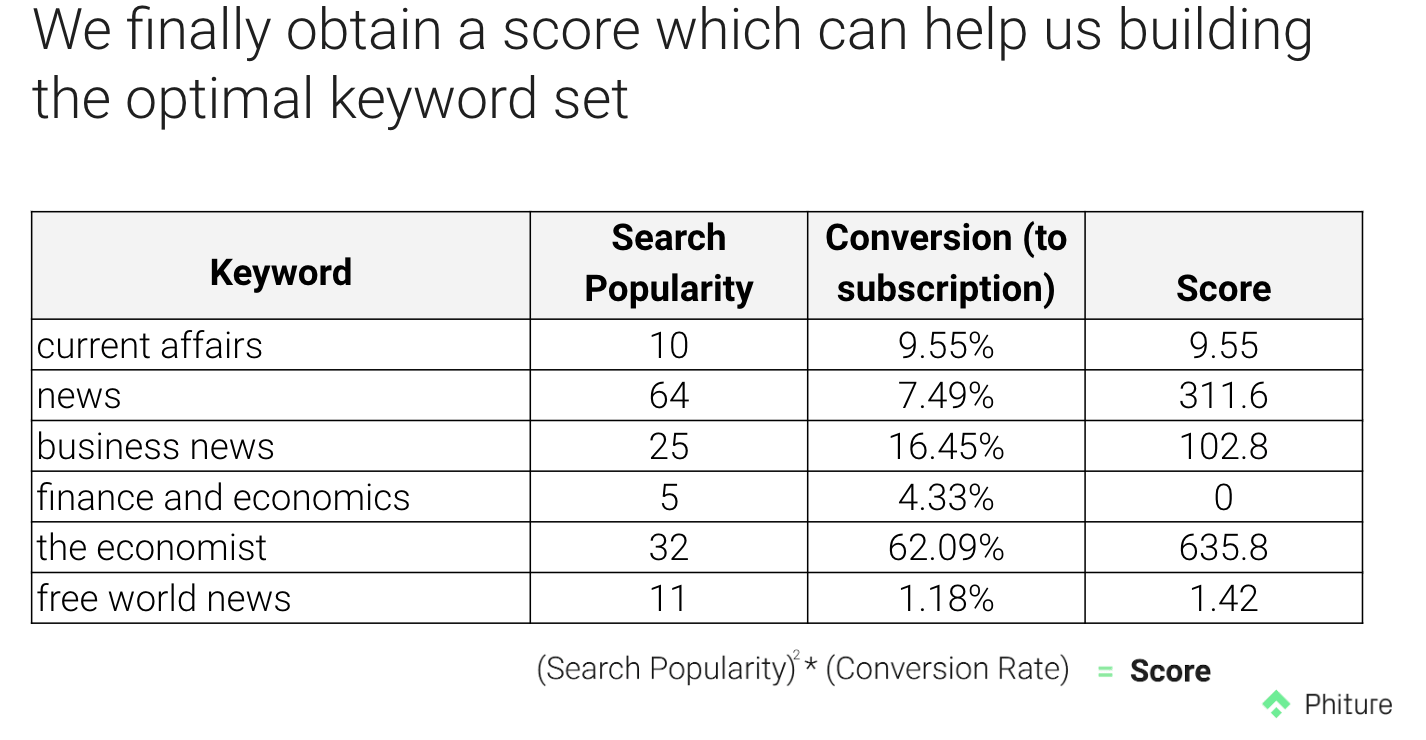
Once we have calculated the score for all our keywords, we know which ones are the most “powerful”. In other words, we can identify which keywords are more likely to deliver the highest combination of Volume and Conversion. Then, we would need to include the keywords with the best scores in our App Store’s keyword set. This action will considerably improve the app’s relevancy for users, due to the increase in relevant metadata, which will increase your visibility and conversions.
Therefore, including these most “powerful” keywords in your 100 character keyword field enables you to create the optimal keyword set for the App Store.
In sum, the optimal keyword set maximizes two parameters:
- Volume
- Conversion
The Benefits of utilizing this approach is that:
- You’re basing your research and selection of keywords on data.
- Because of the utilization of Apple Search Ads, you are able to select keywords based on conversion, which eliminate human bias. We’re now completely following data, which makes our choices 100% objective.
- We are completely methodical as we’re following a predetermined approach.
- By selecting a Conversion event which lies in your lower funnel, we would maximize for revenue instead of installs (subscriptions instead of installs).
If you liked this post, leave a 👏 and share it on your social media. If you have suggestions or questions about our Apple Search Ads campaign structure, please do let us know in the comments below 👇.
Discover more about Phiture’s Apple Search Ads managed services, our ASO eBook or join our Slack channel to learn more about ASO and ASA.
















